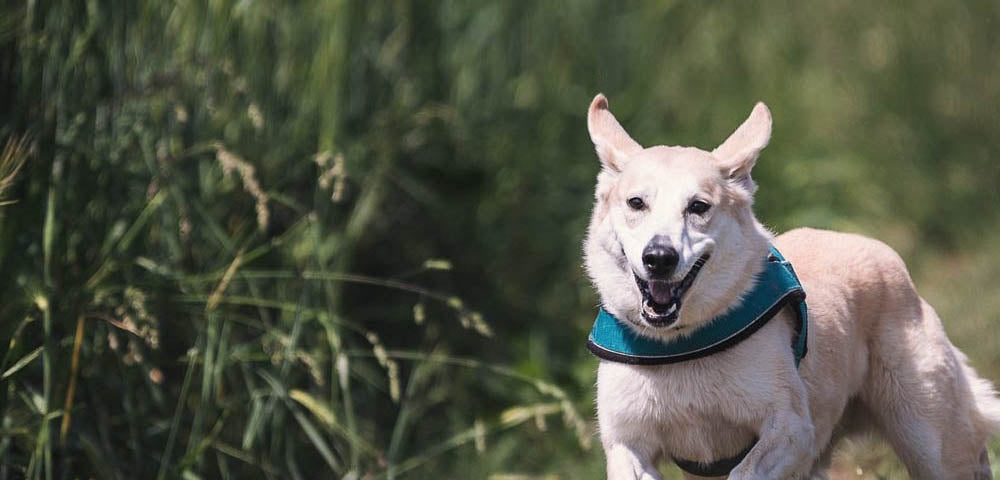Anxiety is officially the most common psychiatric malady facing Americans of all ages. But, did you know that dogs can suffer from it too? A dog’s generalized anxiety may be due to various reasons, such as aging, a history of abuse with a previous owner, or prolonged separation. However, even otherwise happy and healthy dogs may suffer from situation anxiety, too. The times a dog may feel anxious include while at the vet and/or grooming visits, during fireworks celebrations, and throughout thunderstorms.
How to Identify Symptoms of Dog Anxiety?
Separation anxiety is what most dog parents are concerned about when it comes to general dog anxiety. The main reason for this is that separation anxiety can lead to the destruction of property, such as chewing through furniture and shoes or wetting the carpet.
Identifying symptoms of situational anxiety, that in the moment, for temporary and irregular stimuli may be trickier. Even so, here are some clear signs your dog may be suffering from stress or anxiety:
- Your dog may bolt, or attempt to bolt, to get away from the stimuli.
- Your dog may try to hide and may remain hidden even when called.
- Your dog may lose their appetite, sometimes even resisting their favorite foods. Some dogs may also suffer stomach upsets and diarrhea.
- Your dog may remain with you or return when called, but may tremble, become withdrawn or tuck their tails between their legs.
- Your dog may begin to lick, chew, and bite at themselves, especially their paws.
How to Calm Dog Anxiety Naturally
12 Ways to Help Treat Dog Anxiety
The good news is that regardless of the reason behind your dog’s anxiety, there are several ways to calm them and improve their quality of life. See below for some solutions.
1. Dog Calming Treats
What do dogs love more than treats? Perhaps only you. They may love you even more for sharing some tasty dog calming treats with them. Waggedy provides dog calming soft chew treats with melatonin to help dogs overcome their anxiety. In addition to improving a dog’s mental health, soft chews help to reduce excessive barking, and other negative behaviors dogs may develop to cope with their anxiety. A natural dog-calming treat may even spare your sofa or that new pair of shoes.

Our Calm can offer needed relief to your dog's anxiety symptoms. it is an all natural dog supplement scientifically formulated to help reduce stress and anxiety in dogs. This product helps calm your dog’s nerves during grooming (creating a safer environment for your dog and the groomer), traveling in a car or plane, unusual weather events (rain, wind storms, thunder, and lightning) and any other loud or disturbing noises.
2. CBD Oil
Some people may use CBD oil extracted from hemp to manage their anxiety naturally. According to the American Kennel Club, owners may be able to use this to manage their dog’s anxiety and stress as well. It is important to note, however, that CBD oil is not yet regulated. As a result, there is no set standard to verify the ingredients or potency. This lack of standards may make it potentially dangerous if the manufacturer is not reliable. It is best to research and pick a source that you or others trust. Always consult a vet before introducing CBD or any other types of human-grade herbs and medicines to your dog.
3. Training and Conditioning
Many dogs may begin to show anxiety long before they make it to the vet or groomer. Just the mere sight of the carrier is enough to send them hiding under the bed or in the closet, no matter how often you call them or hold out bits of bacon. The American Kennel Club recommends counter conditioning to change how your dog responds to certain stimuli. Many owners accomplish this by placing treats inside the carrier and placing it in various locations around the home on days when they have no intention of bringing their dog to the vet or groomer.

4. Desensitization
The American Kennel Club also recommends desensitization. Sometimes dogs fear loud sounds or vet/groomer visits due to limited exposure. Repeated exposure to the activities that cause fear may help to increase familiarity in a natural manner. However, this will not work for all dogs or all stimuli. Some concerns may run too deep or are as a result of previous trauma.
5. Exercise and Nutrition
Staying active and maintaining a healthy diet is as good for dogs as it is for humans. Dogs may become less anxious naturally if they get to work off their extra energy with long walks down the street or runs in the park. Even playtime in the backyard or on the living room floor may be sufficient. When it comes to nutrition, it may be wise to limit how much table food your dog consumes. Table food is one of the primary sources of toxins your dog may accidentally ingest, such as chocolate cake or raisins.

As dogs age, it’s important they get the right vitamins and supplements to support their continued development through adulthood. Our Daily Essentials' time-released tablet is designed for dogs over a year old and is completely safe for sick, pregnant or nursing dogs. Promote your dogs health and nutrition and give them the pet vitamins and supplements they need!
6. Canine Music
According to PetMD, one way to calm dogs is to play music developed specifically for them. Some dogs may like to hear specific music played in the house, that you know what works already. However, there is music explicitly developed for dogs to calm them and reduce anxiety. Some dog owners claim this works. You may be able to play this in the house during a storm or in the car on the way to the vet. Or if you're musically inclined, they may love music you play.

7. Physical Contact
Some dogs are calmest when near their humans, mother nature's remedy. Because of this, even in the most stressful situations, they may wish to cuddle up next to you. When you’re working, sick, or need some alone time, this can be problematic. However, even a few minutes may help to reduce your dog’s anxiety. Ear scratches, tummy rubs, or whatever kind of contact your dog enjoys may also help to distract them from whatever has caused their distress.
8. Aromatherapy
Aromatherapy is recommended to calm humans and create a serene environment. Dogs may benefit from this as well. Note that the oils and sprays that work on humans may not work on dogs – but some specific sprays and balms may create a calming feeling in canines. If your dog has a particular safe spot in your home, consider using these in the area during a thunderstorm or fireworks. It may also be beneficial for carriers or in the car on the way to a veterinarian appointment. Also, be sure to check how you react to these sprays and scents before using them in large quantities, as an allergic reaction is possible.

9. Self-Check
How you react to a dog’s anxiety may not necessarily cure it, but it may help to make it better or worse. For example, if a dog panics at the sound of fireworks and you also panic at the dog panicking, you have a recipe for disaster. The dog may pick up on your response and use it as confirmation that there is a good reason to feel as though they are in danger. The excitement may make it difficult to calm them down. It is better to remain calm and try to reassure them.
10. Situation Avoidance
Some dogs will never outgrow their anxiety, or for some, old age is the source of their distress. Like humans, dogs may begin to lose cognitive function and develop dementia as they age. This results in confusion, which may trigger fear in senior dogs. In these instances, it may be best to make other plans if fireworks will be in your area. During thunderstorms, you may need to provide a safe space for the dog to hide until the storm has passed. As for the vet, you may be able to schedule vet visits in your own home. Ask around to find out if there are vets in your areas that do house calls.

11. Early Socialization
The old cliché goes that prevention is better than a cure, and this is true for anxiety in dogs. While not every dog owner has the privilege of raising their dogs from puppyhood, when you do, it’s best to socialize dogs from an early age. Early and regular exposure to your veterinarian and groomer, car rides, fireworks, and thunderstorms may make these things seem commonplace to dogs, even as they begin to age into their senior years.
12. Anxiety Medication
Some dogs may require ongoing prescription-grade medication for severe anxiety and depression. This may or may not be natural depending on the medication. We've included it on this list as it may be needed in some cases. Only a veterinarian can provide this and will require a full evaluation of your dog. If your vet decides your dog is a candidate for prescription medication, they may prescribe antidepressants and benzodiazepine. While benzodiazepine is also used to treat anxiety in humans, never attempt to medicate your dog until you receive clear instructions from a vet. This should be a last resort for most dogs.

Anxiety is the source of many of the behavior problems dog parents struggle with at home, on road trips, and at the park. To help protect your dog from presenting a danger to themselves and others, try the some of the natural ideas provided above. Note also that anxiety may be a symptom of serious underlying issues, so if anxiety is ongoing and persistent, seek professional advice from your veterinarian.


